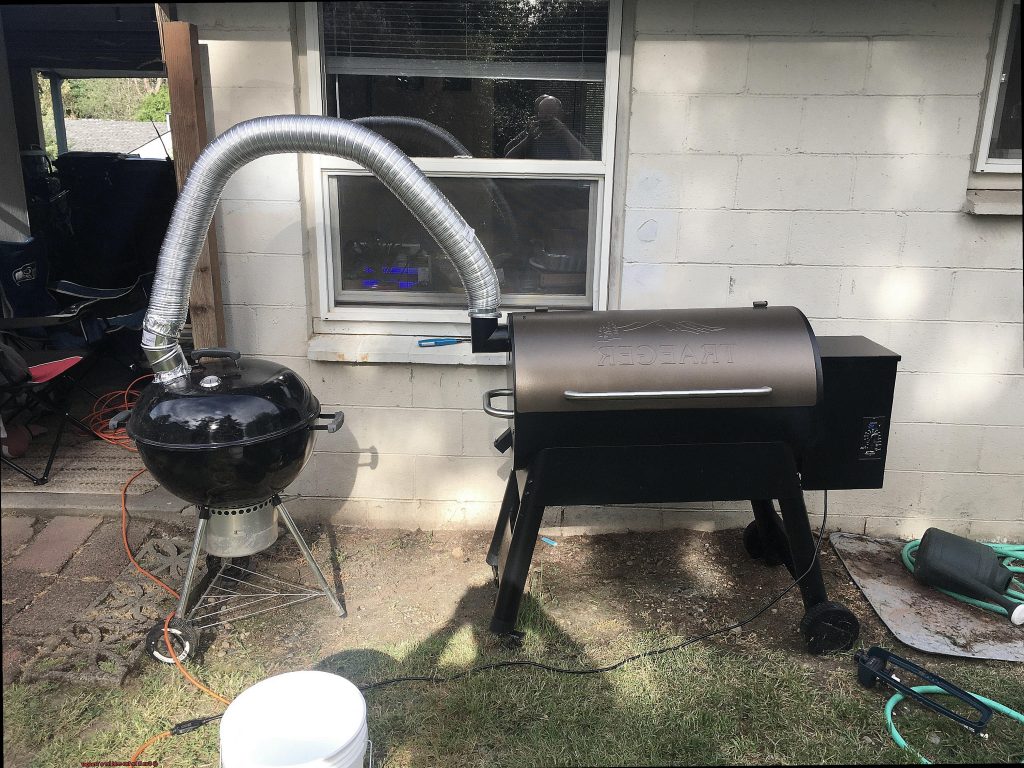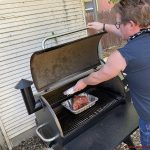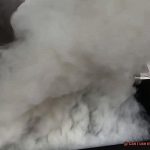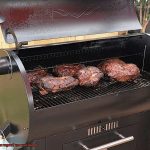Winter has arrived, and while some may prefer to stay indoors wrapped in a cozy blanket, true grill enthusiasts know that the cold weather should not stop them from enjoying their Traeger grill. But can it be too cold for a Traeger? Yes, it can. Even though Traeger grills are known for their versatility and ability to cook just about anything, they are designed to operate within a specific temperature range. When the temperature drops below that range, the grill’s performance can be affected.
In this article, we’ll explore the ideal temperature range for Traeger grills and how to overcome common problems that arise in colder temperatures. We’ll also share tips on how to maintain your grill’s performance in the winter season.
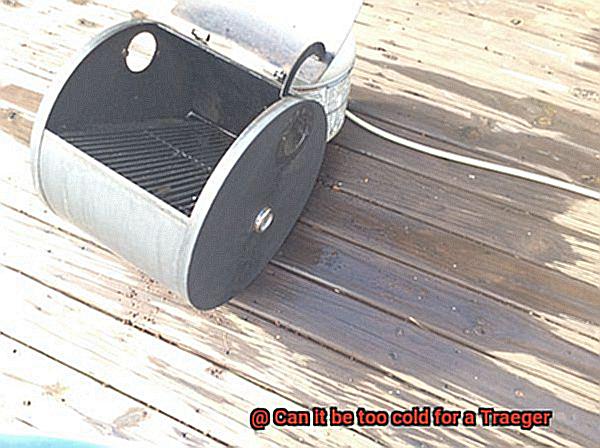
So bundle up and grab your favorite warm beverage because we’re about to dive into the world of Traeger grilling in chilly weather. We’ll cover everything from why extreme cold can impact your Traeger’s performance, to how you can ensure your grill stays hot even when the temperatures drop. By the end of this article, you’ll have all the knowledge you need to keep grilling all winter long.
Contents
What is a Traeger Grill?
If you’re looking to elevate your outdoor cooking game and branch out from traditional gas or charcoal grills, a Traeger Grill may be just what you need.
At its core, a Traeger Grill is a wood pellet grill that uses real wood pellets as fuel to cook food. The electric auger system feeds the pellets from a hopper into a firebox, which ignites the pellets to create heat and smoke. This process infuses your food with authentic smoky flavor that can’t be replicated with other types of grills.
But a Traeger Grill is more than just a one-trick pony. These grills are renowned for their versatility, allowing you to grill, smoke, bake, roast, braise, and BBQ all on one machine. Whether you’re cooking up a feast for a backyard barbecue or packing up for a tailgating party, there’s a Traeger Grill size that fits your needs.
One of the biggest draws of a Traeger Grill is its digital controller. This feature lets you easily control the temperature and cooking time with precision, ensuring that your food is cooked perfectly every time. No more hovering over the grill or fiddling with vents – just set it and forget it.
But what about using a Traeger Grill in cold weather? Extreme temperatures can impact performance, but there are steps you can take to ensure success. Proper insulation is key to maintaining consistent temperature and avoiding issues with the auger system. A thermal blanket or jacket can also help retain heat. And don’t forget to adjust your cooking times accordingly – colder temperatures may require longer cooking times.
Cold Weather Impact on Performance
But as the temperatures start to drop, it’s important to understand how cold weather can impact your grill’s performance. Luckily, with some simple adjustments and preparations, you can still enjoy mouthwatering masterpieces all year round.
Let’s begin with a common issue faced during cold weather – difficulty starting your Traeger. The pellets used as fuel can absorb moisture from the air, making them harder to ignite. However, storing your pellets in a dry location and using a moisture-resistant cover will help combat this problem.
Another factor that can affect your Traeger’s performance in cold weather is its ability to reach and maintain its desired temperature. The ambient temperature outside can cause the grill to take longer to heat up and maintain its temperature. To counteract this, consider increasing the temperature setting on your Traeger or allowing for longer preheating time before adding food.
It’s essential to note that extremely low temperatures (below 20°F) may cause issues with your Traeger’s electronics and moving parts. In such cases, it may be best to avoid using your grill entirely until temperatures rise.
To summarize, here are some tips to help you overcome the impact of cold weather on your Traeger’s performance:
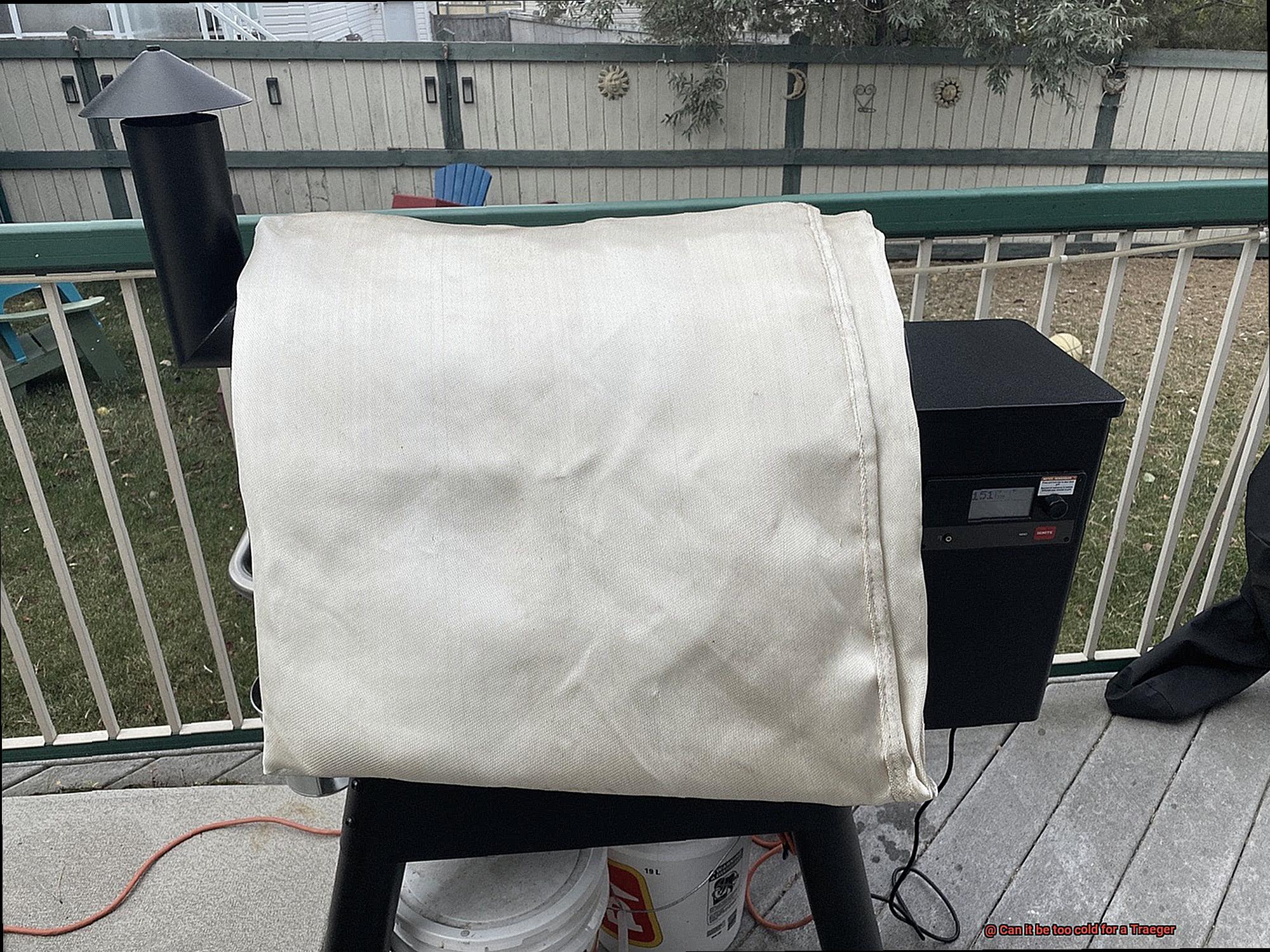
- Store your pellets in a dry place and use a moisture-resistant cover for your grill
- Increase the temperature setting on your Traeger or allow for more preheating time
- Avoid using your grill during extremely low temperatures
Issues with Wood Pellets in Colder Temperatures
While wood pellets are known for their clean-burning and consistent heat output, colder temperatures can pose some issues that can affect your grill’s performance. Let’s explore some of these issues and how to avoid them.
Firstly, damp or frozen wood pellets can cause major problems for your Traeger grill. The pellets can stick together, clogging up the auger and preventing them from reaching the firepot. This can result in a failure to reach the desired temperature or even a complete grill shutdown. To avoid this, it is essential to store your pellets in a dry and warm location. If you live in a region with extremely cold temperatures, it is best to store them indoors or in a heated garage. You can also invest in a pellet storage container or bag to protect your pellets from moisture.
Another issue with wood pellets in colder temperatures is that they may not burn efficiently. Cooler air can cause incomplete combustion and increased ash production, resulting in poor grilling performance. To prevent this, keep a close eye on your grill’s temperature and adjust the settings accordingly. By doing so, you’ll ensure optimal performance and a successful grilling experience.
Longer Heating Time in Cold Weather
Winter is the season for bundling up and enjoying delicious meals cooked on your Traeger grill. However, you might have noticed that the chilly weather can lead to longer heating times than usual. Fear not, because we’re here to help you understand why this happens and how you can overcome it.
When the temperature drops, it is common for grills to take longer to heat up, and Traegers are no exception. The cold air can cause the pellets to burn less efficiently, resulting in lower temperatures and longer heating times. But there are a few solutions to this problem.
Firstly, using higher quality pellets with a higher BTU rating will ensure that the pellets burn more efficiently, producing more heat and reducing the time it takes to reach the desired temperature. Another solution is preheating your grill for a longer period of time before cooking. This will allow the grill to warm up gradually, giving the pellets enough time to burn more efficiently.
It is also important to note that using a Traeger grill cover can help insulate the grill and maintain a consistent temperature. This is especially important in cold weather as it helps prevent heat loss and reduces heating times. Additionally, using a Traeger insulation blanket is an effective way to keep the grill warm in extremely cold temperatures.
When cooking in colder weather, keep in mind that food may take longer to cook due to lower temperatures. Be sure to monitor cooking times and adjust accordingly. With these tips in mind, you’ll be able to enjoy delicious grilled meals even in colder weather with your Traeger grill.
Is it Possible to Use a Traeger in Extremely Cold Temperatures?
The answer is yes, but there are certain precautions you need to take to ensure your grill works at its best even in frigid conditions.
Firstly, let’s talk about the pellets. In extremely cold temperatures, they can absorb moisture from the air and potentially clog the auger. Store your pellets in a dry place and keep them covered until you’re ready to use them. This will prevent moisture from affecting their performance.
Next, consider the potential for your grill’s components to freeze. Preheat your grill before use and regularly check for any signs of freezing or damage. Taking these steps will help ensure your grill is working efficiently.
It’s also important to note that Traegers may take longer to reach and maintain desired temperatures in extremely cold conditions. Factors such as outdoor temperature and wind chill can affect the grill’s ability to heat up and stay hot. To combat this, use a thermal blanket or wrap your grill in an insulated material to help retain heat.
To summarize, here are the key takeaways:
- Store pellets in a dry place and keep them covered until use
- Preheat your grill before use and check for freezing or damage
- Use a thermal blanket or insulation material to retain heat
Steps to Insulate Your Grill for Cold Weather Grilling
Then, you know that proper insulation of your grill is the key to enjoying perfectly cooked food every time. Insulating your grill helps maintain a consistent temperature and prevents heat loss, which can lead to longer cooking times and undercooked food. Here are the steps you should take to insulate your grill for cold weather grilling.
Invest in a Good Quality Grill Cover:
The first step towards proper insulation is investing in a high-quality grill cover. A good cover will protect your grill from the elements and keep it dry, preventing rust and other damage. It will also keep out moisture that can cause pellets to clump and clog the auger, ensuring a smooth grilling experience.
Use Insulation Blankets or Jackets:
Insulation blankets or jackets designed specifically for your Traeger grill are another excellent way to insulate your grill. Made from high-quality materials like fiberglass or ceramic fiber, these blankets retain heat and prevent heat loss. They’re easy to install and remove, making them perfect for those chilly winter months.
Pay Attention to Placement:
Placement is crucial when it comes to grilling in cold weather. Find a sheltered spot that’s protected from the wind and other elements as this can help reduce heat loss and maintain a consistent cooking temperature. Also, ensure the ground under your grill is level and stable to avoid accidents.
Use Thermal Mass:
Using bricks or stones as thermal mass can help retain heat inside your grill. Place them inside your grill before you start cooking, and they’ll absorb excess heat, releasing it slowly throughout the cooking process, maintaining a consistent temperature.
Adjusting Cooking Times When Using a Traeger in Colder Temperatures
Grilling in the colder months can be a thrilling experience, but it comes with its own set of challenges. If you’re using a Traeger in colder temperatures, it’s essential to adjust the cooking time of your food. This is because colder temperatures can affect the performance of your Traeger, which, in turn, affects the cooking time of your food.
To start, one way to adjust for this is by increasing the temperature setting on your Traeger. This will help balance out the colder temperatures outside and ensure that your food cooks at the desired rate. Do note that this may require additional pellets to maintain the higher temperature level.
But what if you don’t want to increase the temperature? Then it’s time to increase your cooking time. By giving your food more time to cook through, you can ensure that it reaches its appropriate internal temperature, even if it’s colder outside than ideal. It’s important to keep an eye on your food and use a meat thermometer to ensure that it’s fully cooked.
It’s also important to consider the type of food you’re cooking when adjusting cooking times. For instance, thicker cuts of meat may take longer to cook in colder temperatures, while thinner cuts may not be as impacted. Adjust your cooking time accordingly based on what you’re preparing.
In addition to adjusting cooking time, insulation plays a crucial role in cold weather grilling. Investing in a high-quality cover, using insulation blankets or jackets, finding a sheltered spot for placement, and incorporating thermal mass like bricks or stones will go a long way in maintaining the desired temperature.
tBGYm4-7h0o” >
Conclusion
To sum up, don’t let the cold weather deter you from using your beloved Traeger grill. However, it’s crucial to keep in mind that Traeger grills are engineered to function within a specific temperature range. When the temperature falls below that range, the grill’s performance can be affected. To conquer the common challenges of colder temperatures, we’ve delved into the ideal temperature range for Traeger grills and how to maintain your grill’s efficiency during winter.
We’ve discussed issues such as starting difficulties, wood pellets’ impact on performance in colder temperatures, longer heating time, and adjusting cooking times when using a Traeger in colder temperatures. We’ve also highlighted precautions such as storing pellets in a dry place and keeping them covered until use, preheating your grill before use and checking for freezing or damage, using a thermal blanket or insulation material to retain heat, investing in a high-quality cover, using insulation blankets or jackets, finding a sheltered spot for placement and incorporating thermal mass like bricks or stones.
By adhering to these simple tips and precautions mentioned above, you can savor delicious grilled meals even in chilly weather with your Traeger grill. So bundle up and grab your favorite warm beverage because you’re now ready to dive into the world of Traeger grilling in cold weather.

